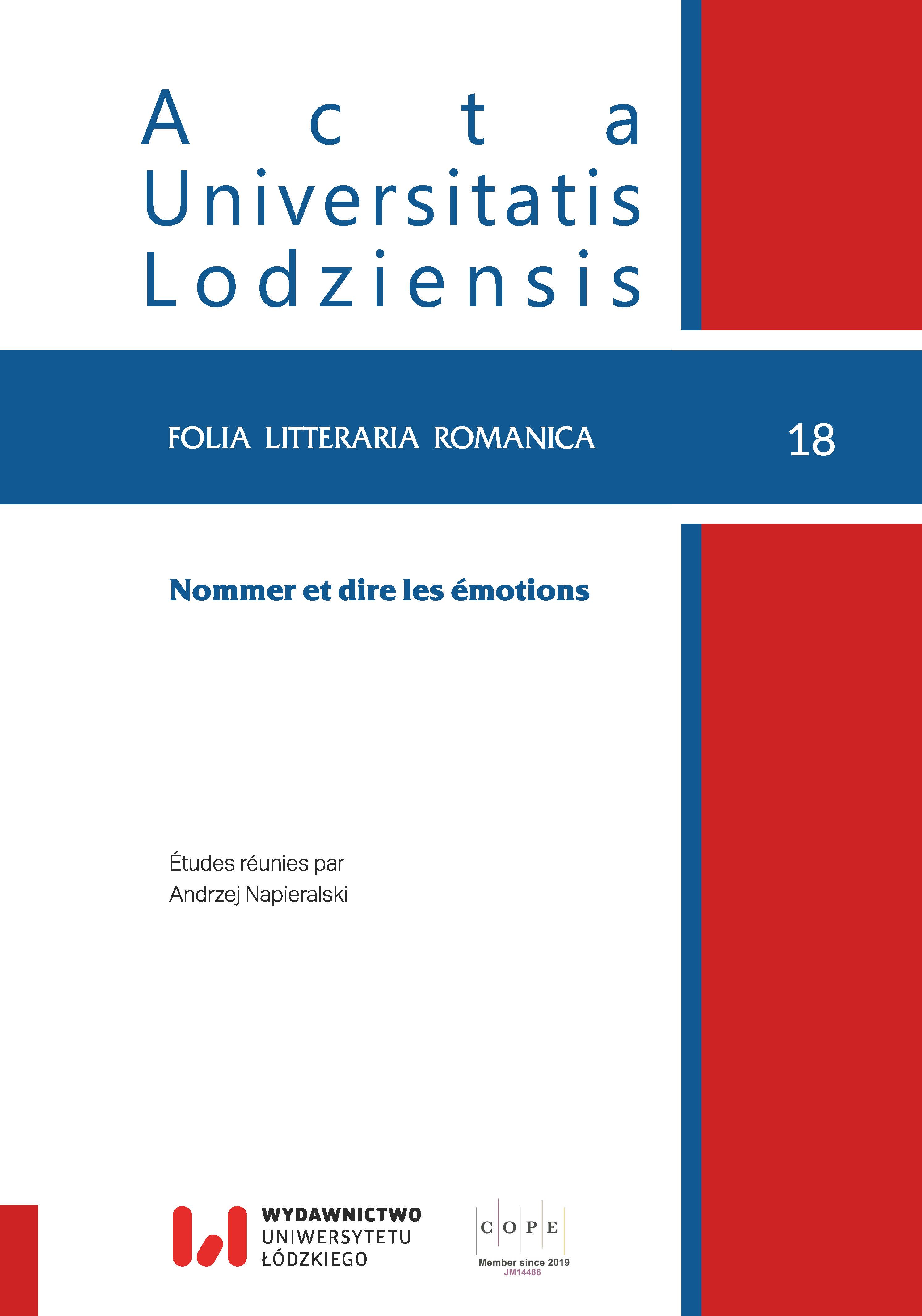The Theory and Practice of Teaching the Phraseology of the Lexicon of Affects in French as a Foreign Language
DOI:
https://doi.org/10.18778/1505-9065.18.11Keywords:
phraseology, lexicon of feeling, didactics of French as a foreign languageAbstract
This article is situated in the perspective of a new lexical approach to French as a foreign language dealing with emotions and feelings. More specifically, we will address the issue of teaching phraseology in the context of FLE, particularly phraseology related to feelings. Two main branches of research in linguistics situate the work to which we refer: on the one hand – lexicology from the point of view of the combinatorics of lexical units, and on the other hand – construction grammar. Both branches have in common paying particular attention to phraseological units. To do this, we begin with a terminological and methodological overview of phraseological units. We then present Novakova’s functional model, which we will try to apply to the lexicon of commercial transactions. Finally, we will return to the didactic approach proposed by Cavalla and Labre (2009), and we will illustrate the phraseology of the lexicon in terms of commercial transactions.
Downloads
References
BLUMENTHAL, Peter, (2007), « A used-based French dictionary of collocations », in Corpus-Based Perspective in Linguistics (Y. Kawaguchi, T. Takagaki, N. Tomimori, T. Tsuruga éds), Amsterdam and Philadelphia, Benjamins, p. 67-83
Google Scholar
BLUMENTHAL, Peter (2009), « L’actualisation des noms d’affect », in Les configurations du sens (P. Blumenthal, S. Mejri éds), vol. 37, Stuttgart, Franz Steiner Verlag, p.13-25
Google Scholar
BLUMENTHAL, Peter (2014), « Caractéristiques et effets de la complexité sémantique des noms d’affects », in Les émotions dans le discours / Emotions in Discourse (P. Blumenthal, I. Novakova, D. Siepmann éds), Frankfurt am Main, Peter Lang, p. 175-186
Google Scholar
DOI: https://doi.org/10.3726/978-3-653-03879-8
BOUVERET, Myriam, LEGALLOIS, Dominique (2012), Constructions in French, Amsterdam-Philadelphia, John Benjamins Publishing Company
Google Scholar
DOI: https://doi.org/10.1075/cal.13
BUVET, Pierre-André, GIRARDIN, Chantal, GROSS, Gaston, GROUD, Claudette, (2005), « Les prédicats d’affecte », Lidil, no 32. (https://doi.org/10.4000/lidil.104)
Google Scholar
DOI: https://doi.org/10.4000/lidil.104
BYBEE, Joan (2007), Frequency of Use and the Organization of Language, Oxford, Oxford University Press
Google Scholar
DOI: https://doi.org/10.1093/acprof:oso/9780195301571.001.0001
BYBEE, Joan (2010), Language, Usage and Cognition, Cambridge, Cambridge University Press
Google Scholar
DOI: https://doi.org/10.1017/CBO9780511750526
CAVALLA, Cristelle (2009), « La phraséologie en classe de FLE », Les langues modernes. (https://hal.science/hal-00699916v1/file/cavalla_2009_langues_modernes.pdf, consulté le 11 novembre 2021)
Google Scholar
CAVALLA, Cristelle, CROZIER, Elsa (2005), Émotions sentiments, Grenoble, Presses universitaires de Grenoble
Google Scholar
CAVALLA, Cristelle, CROZIER, Elsa, DUMAREST, Danièle, RICHOU, Claude, (2009), Le vocabulaire en classe de langue, Paris, CLE International
Google Scholar
CAVALLA, Cristelle, LABRÉ, Virginie (2009), « L’enseignement en FLE de la phraséologie du lexique des affects », in Le lexique des émotions et sa combinatoire lexicale et syntaxique (A. Tutin, I. Novakova éds), Grenoble, Ellug, p. 297-316
Google Scholar
DOI: https://doi.org/10.4000/books.ugaeditions.7149
CAVALLA, Cristelle, TUTIN, Agnès, NOVAKOVA, Iva, GROSSMANN, Francis (2006), « Esquisse de typologie des noms d’affect à partir de leurs propriétés combinatoires », Langue française, n° 150, p. 32-49
Google Scholar
DOI: https://doi.org/10.3917/lf.150.0032
COWIE, Anthony Paul (éd.), [1998], (2005), Phraseology. Theory, Analysis and Applications, Oxford, Oxford University Press
Google Scholar
DIK, Simon. C., (1997), The Theory of Functional Grammar. 1. The Structure of the Clause. 2. Complex and Derived Constructions, Berlin, Mouton de Gruyter
Google Scholar
GARY-PRIEUR, Marie-Noëlle, (2011), Les déterminants du français, Paris, Ophrys GOLDBERG, Adele. E. (1995), Constructions: A Construction Grammar Approach to Argument Structure, Chicago, University of Chicago Press
Google Scholar
GONZÁLEZ REY, Isabel (2002), La phraséologie du français, Toulouse, Presses Universitaires du Midi
Google Scholar
GONZÁLEZ-REY, Isabel (2008), « La didactique du français idiomatique », Fernelmont, E.M.E
Google Scholar
GROSS, Gaston (1996), Les expressions figées en français. Noms composés et autres locutions, Paris, Ophrys
Google Scholar
LABRÉ, Virginie (2006), « Expressions figées et collocations des sentiments : analyse didactique pour la classe de FLE », mémoire 1re année Master Français Langue Etrangère Professionnel, ss.dir. C. Cavalla, Université Stendhal-Grenoble3
Google Scholar
LEGALLOIS, Dominique (2016), « La notion de construction », Encyclopédie grammaticale du français. (http://encyclogram.fr/notx/012/012_Notice.php , consulté le 11 novembre 2021)
Google Scholar
MARTIN, Robert (1997), « Sur les facteurs du figement lexical », in La locution entre langue et usages (M. Martins-Baltar éd.), Paris, Ophrys, p. 291-305
Google Scholar
DOI: https://doi.org/10.4000/books.enseditions.18803
MEJRI, Salah (2002), « Traduction, poésie, figement et jeux de mots », Meta : journal des traducteurs, n° 45/3, p. 412–423
Google Scholar
DOI: https://doi.org/10.7202/003612ar
NOVAKOVA, Iva (2015), « Les émotions entre lexique et discours », in La sémantique et ses interfaces (A. Rabatel, A. Ferra-Léturgie, A. Léturgie éds), Limoges, Lambert-Lucas, p. 181-204
Google Scholar
NOVAKOVA, Iva, SORBA, Julie (2018), « La construction du sens autour des lexies d’affect : proposition d’un modèle fonctionnel », Langages, n° 210, p. 55-70
Google Scholar
DOI: https://doi.org/10.3917/lang.210.0055
NOVAKOVA, Iva, TUTIN, Agnès (dir.), (2009), Le lexique des émotions, Grenoble, Éditions littéraires et linguistiques de l’Université de Grenoble
Google Scholar
PUCKICA, Jérôme (2007), « Les grammaires de construction », Anglophonia (French journal of English Linguistics), p. 69-80
Google Scholar
DOI: https://doi.org/10.4000/anglophonia.781
REY, Alain, CHANTREAU, Sophie (2007), Préface, Dictionnaire des expressions et locutions, Paris, Le Robert
Google Scholar
SINCLAIR, John (1991), Corpus, Concordance, Collocation, Oxford, Oxford University Press
Google Scholar
SINCLAIR, John (2004), Trust the Text. Language, corpus and discourse, Londres, New York, Routledge
Google Scholar
DOI: https://doi.org/10.4324/9780203594070
Downloads
Published
Versions
- 2023-10-30 (2)
- 2023-10-30 (1)
How to Cite
Issue
Section
License

This work is licensed under a Creative Commons Attribution-NonCommercial-NoDerivatives 4.0 International License.













